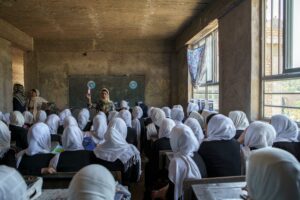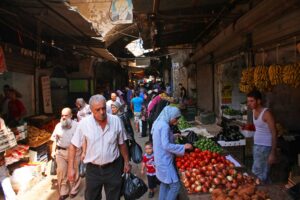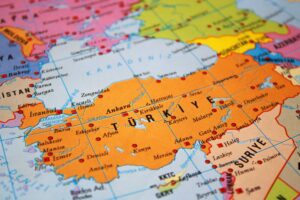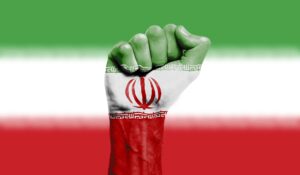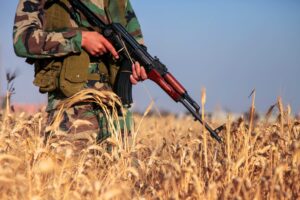The matter of women and girls’ rights to education and their historical exclusion from educational spaces, particularly in reference to the Taliban, has proven perhaps the most prominent point of discussion for Western commentary on Afghanistan[i] [ii] [iii]. Since the Taliban takeover in 2021, women and girls have been systematically removed from education after two decades of educational freedom facilitated by the democratic republic[iv]. Despite the recent crackdown on female education, the courageous women of Afghanistan remain persistent in their quest to continue their education.
Pashtana Dorani, a 25-year-old Afghan refugee, set up LEARN Afghanistan in 2018, under the democratic government, to help improve education for girls in Afghanistan.[v] LEARN is a multi-faceted organisation which utilises both online and offline resources and provides access to quality education for children in underprivileged communities and children from rural areas in Afghanistan via in-person and remote learning. The organisation focuses on the potential and growing phenomenon of digital literacy, and how it can be manoeuvred to improve female literacy and access to education across Afghanistan. Prior to the Taliban takeover, LEARN operated 18 digital schools in cities and rural regions across southern Afghanistan. When the Taliban retook the country last fall, the organisation was forced to dissolve the majority of its programmes and shift its remaining activities underground.[vi]
I sat down with Pashtana to discuss the topic of female education in Afghanistan. We interrogated the issues which led to the underdevelopment of female education during the American-backed democratic republic, and how her organisation seeks to address and remedy these deficiencies by embracing new digital technology. Finally, we discussed the challenges that a re-established Taliban rule has caused for LEARN, and female education in Afghanistan more broadly.
Confronting the Importance of Education
That is what inspired me, the realisation that something I took for granted was impossible for other people to have.
During the Taliban’s first stint in power, Pashtana’s family fled Afghanistan. She spent her childhood in a refugee camp in Pakistan. The refugee camp had no existing means of education, and the nearest school was 10 miles away. Pashtana’s father, who had previously been a tribal leader in her hometown of Maruf, decided to open a school for girls in the refugee camp to provide young girls like Pashtana with a basic education. Her parents assumed the roles of teachers at the school and hosted more than 70 girls per day in their home to provide an informal education for them.
For Pashtana growing up, education was never optional. “It was a given” she explained, “it wasn’t something you needed to appreciate, it was just something you needed to do.” It wasn’t until Pashtana returned to Afghanistan in 2017 that she was confronted with the stark reality of life for most Afghan girls: education was a privilege that many were not granted.
Pashtana’s hometown, Maruf, was a rural village in the district of Kandahar, an area which remained a stronghold[vii] for the Taliban during the 20 years of the US-backed democratic republic and was consequently the target of incessant bombings[viii] and air raids[ix]. As a result, during the onslaught that plagued the past 20 years, the people of Maruf became internally displaced and were forced to migrate to Spin Boldak, where IDP (Internally Displaced People) camps were erected to temporarily house more than 35,000 people.[x]
Unlike in the refugee camp that Pashtana was raised in, these make-shift IDP camps did not provide any educational facilities or informal teaching, especially not for girls. “This trip to Afghanistan shattered my worldview” Pashtana declared, “I realised two important things: that my people were internally displaced in their own country, and that they had been abandoned with no access to basic necessities like healthcare and education”. Pashtana declared that this was not an unusual occurrence in Afghanistan at this time, and that it was representative of a wider Modus Operandi of neglect from the government.
“That is what inspired me, the realisation that something I took for granted was impossible for other people to have” Pashtana confessed, explaining that her shock and sadness upon discovering the conditions which girls in Afghanistan found themselves inspired her to begin her organisation, LEARN.
Girls’ Education and the Democratic Republic
Education is not a project.
During the 20 years of the US-backed republic, female education was centralised as a priority owing in large to a push from the international community toward the protection and projection of women’s rights. During this period, many schools were erected, and funding was pumped into creating the infrastructure to ensure that girls were included in the education system[xi]. However, literacy rates among girls remained astonishingly low, with the most recent data suggesting only a 23% female literacy rate in Afghanistan.[xii] This is notably low compared to other countries in the region like the UAE and Qatar, which have a female literacy rate of 97%[xiii] and 95%[xiv] respectively. Similarly, over 1/3rd of girls in Afghanistan were married off by their families before the age of 18, after which they were forced to leave education to focus on the domestic sphere[xv].
When asked about the state of girls’ education in Afghanistan during this period, Pashtana was highly critical. According to her, despite the West’s portrayal of a progressive government which prioritised women and education[xvi], the reality was woefully different. “In all honesty, the government was corrupt”, Pashtana confessed. “They were stealing salaries and funding from schools”. She went on to explain that the Ministry of Education would publish records of schools which, in reality did not exist. Pashtana referred to such institutions as ‘ghost schools.’[xvii] This means that funding would seemingly be channelled into developing the country’s education infrastructure, however there would be no follow-up after the fact, resulting in no school having actually been built. Despite no school existing, the ghost institution would still be incorporated into national statistics and reports as success stories. In the instance where the schools were built, a lack of attendance and registration would result in the similar phenomenon of ‘ghost teachers’ and ghost students. Pashtana is not the first to accuse the democratic government of this practice[xviii]. In 2015, it was discovered that over $1bn of US funding toward Afghan education had been channelled toward the creation of ‘ghost schools’, with as many as 1 in 12 schools having no teachers or students.[xix]
Pashtana criticised the government and NGOs’ lack of adaptability in their approach to expand female education in Afghanistan, which seemed to continuously result in lacklustre results. “If you are doing something again and again in the same way and it is not producing any results, you need to change your methodology” she reminded me. The specific flaws in the current methodology, according to Pashtana, are the lack of long-term commitment by external actors and the inability to adapt beyond traditional frameworks. As far as Pashtana could tell, these institutions were employing the same method which centralised investing in infrastructure with no real commitment to upholding and supporting education beyond that. “Education is not a project”, Pashtana stated, “you can’t invest in sustaining a school for 18 months and think that is enough. That is only 1 ½ years out of 12 that a girl is going to be in education”.
The Technological Revolution and Girls’ Education
The internet has opened up a new world, and education in Afghanistan must learn to grow within that space.
The failures of the methods used by the democratic government and international NGOs motivated Pashtana to employ a new approach to supporting girls’ education, one which utilised emerging technology to adapt to the needs and circumstances of modern Afghanistan.
“I founded LEARN to introduce a new model”. Centralising technology and digital literacy, Pashtana emphasised the value of utilising the internet and mobile connectivity. “The last century was about the industrial revolution, this century can be about an internet revolution in Afghanistan” she declared. Rather than investing in building physical education centres, Pashtana introduced a hybrid form of teaching which incorporated tools like Google Meet and Zoom, as well as more traditional forms of media like radio, TV, and downloadable online materials.
“Evolution is an essential thing”, she emphasised. Pashtana credits her organisation’s success to the maximisation of this technology; her ability to evolve. “We are the only organisation that is functioning from grade 7-12” she stated, “we are challenging the narrative that change is bad”.
However, challenges accompany the use of the internet as a tool for education, particularly in a country with as limited internet infrastructure as Afghanistan. In 2022, Afghanistan’s internet penetration stood at 22.9%[xx], and only 34% of Afghanistan had access to grid electricity.[xxi] As a result, access to the internet is sparse in some rural communities, making remote working unfeasible in many cases. In light of these considerations, Pashtana acknowledged the importance of employing a hybrid education model, as Afghanistan is yet able to provide the technological infrastructure necessary to sustain fully remote working.
LEARN under the Taliban
Electricity and access to the internet are a huge challenge. It was a challenge before, but it is even more so now.
After the Taliban seized control of the country in August of 2021, women and girls were once again formally excluded from education, and legislation began to be enforced which criminalised female education all together[xxii] [xxiii]. As a result, the remaining girls’ schools and higher education centres were forced to either shut down or adjust their operations to cater to men only.[xxiv] [xxv] For Pashtana, this meant new challenges for the operational capabilities of LEARN.
“Almost instantaneously we lost 90% of our student base”, she recounted. “We had 7000 students and now we have 230”. The criminalisation of female education meant that parents, students, and teachers were faced with the threat of repercussions from the Taliban if they were caught engaging in or facilitating female education. As a result, Pashtana made sure to wipe all traces and personal information of any teachers or students from her organisation’s website to try and protect them from any retroactive punishment from the Taliban.
For the remaining 230 students in Afghanistan who continue to engage with LEARN, there are new operational difficulties which limit their access to education. Due to the criminalisation of female education, operations for LEARN have been forced to move underground and function in a covert setting to avoid exposure. These safety and functional considerations mean that the in-person element of LEARN’s operations has been drastically reduced. The online branch of LEARN’s education model also faces significant challenges under the Taliban. “Electricity and access to the internet are a huge challenge”, Pashtana revealed. “It was a challenge before, but it is even more so now”. Both electricity and the internet have become a luxury in the Taliban’s Afghanistan, as the nation plummets further into economic turmoil and instability. Earlier this year, reports emerged of several cities across Afghanistan facing increasing power cuts.[xxvi] Similarly, the Taliban began restricting internet access and censoring ‘immoral’ websites, limiting LEARN’s ability to project its remote curriculum.[xxvii]
Looking Forward
The goal is a safer, digital Afghanistan.
Despite the new challenges that LEARN faces as a consequence of the Taliban’s reconsolidation of power, Pashtana remains resolved to expand the operations of LEARN and continue to make a positive impact for girls in Afghanistan. “We want to work in all 34 provinces”, she explained. “The goal is a safer, digital Afghanistan.” This goal moves beyond education, and encapsulates more accessible healthcare and employment opportunities too, which she feels can only be achieved through expanding access to education for all children in Afghanistan. “This would give kids access to not only learning but earning”. Once more referencing the importance of adaptability, she identified the necessity for organisations to re-focus their curriculums to teach applicable skills for careers such as doctors, engineers, and midwives. “For a country in crisis, practical skills must be prioritised”.
Beyond her own organisation’s goals, Pashtana expanded her suggestions, this time aimed directly at the international audience. Calling out the Western world’s tendency to respond to crises in the Middle East by channelling funding into the most high-profile organisations, Pashtana reminded me of the inefficiency of the previous educational models employed by such organisations. “It is so important to take a more active interest in what these initiatives entail, and commit and invest in projects that are long-term and leave a genuine footprint”, she asserted. Not only is it important to consider smaller, grass-roots organisations when directing funding toward Afghanistan, it is also important for larger NGOs to reconsider their existing frameworks and models in light of past failures. These organisations could follow Pashtana’s lead in adapting and implementing new strategies to address the issue of girls’ education. Ultimately, as the Taliban’s re-ignited war against women moves into its third year, the restriction on girls’ and women’s education is unlikely to be withdrawn in the near future, and the importance of supporting sustainable and efficient initiatives will remain seminal to keep female education alive, in whatever form it may take.
[i] News.un.org. (2023). Afghan girls and women made focus of International Education Day: UNESCO | UN News. [online] Available at: https://news.un.org/en/story/2023/01/1132637.
[ii] www.unicef.org. (2023). Girls education | UNICEF Afghanistan. [online] Available at: https://www.unicef.org/afghanistan/topics/girls-education?items_per_page=10&page=0&gclid=Cj0KCQjw6cKiBhD5ARIsAKXUdyZ6q5CASlyqSxjdveyeMRU_6dw4PSuvjRJMRRoSn9wXrgXmaGnwDgAaAgCPEALw_wcB
[iii] Farr, G. (2022). Female Education in Afghanistan After the Return of the Taliban. [online] E-International Relations. Available at: https://www.e-ir.info/2022/04/23/female-education-in-afghanistan-after-the-return-of-the-taliban/.
[iv] Unesco.org. (2023). Available at: https://unesdoc.unesco.org/ark:/48223/pf0000139077
[v] LEARN. (2023). Pashtana’s Diary. [online] Available at: https://learnafghan.org/pashtanas-diary/
[vi] Ibid
[vii] Gjevori, E. (2018). The Taliban strike in their heartland. Why is Kandahar so important? [online] The Taliban strike in their heartland. Why is Kandahar so important? Available at: https://www.trtworld.com/asia/the-taliban-strike-in-their-heartland-why-is-kandahar-so-important-20993
[viii] The Independent. (2017). Explosion reported in Afghanistan day after huge blast. [online] Available at: https://www.independent.co.uk/news/world/middle-east/kandahar-attack-afghanistan-city-kabul-car-bomb-herat-assaults-isis-taliban-al-qaeda-a7872181.html
[ix] www.aljazeera.com. (n.d.). Afghan, US forces kill over 80 Taliban fighters, officials say. [online] Available at: https://www.aljazeera.com/news/2019/10/27/afghan-us-forces-kill-over-80-taliban-fighters-officials-say
[x] Kessler (2002). Feature: Aid drying up in Afghanistan’s Spin Boldak region. [online] UNHCR. Available at: https://www.unhcr.org/news/feature-aid-drying-afghanistans-spin-boldak-region.
[xi] Unesco.org. (2023). Available at: https://unesdoc.unesco.org/ark:/48223/pf0000139077 [Accessed 2 May 2023].
[xii] data.worldbank.org. (2022). Literacy rate, adult female (% of females ages 15 and above) – Afghanistan | Data. [online] Available at: https://data.worldbank.org/indicator/SE.ADT.LITR.FE.ZS?locations=AF.
[xiii] World Bank Open Data. (2022). World Bank Open Data. [online] Available at: https://data.worldbank.org/indicator/SE.ADT.LITR.FE.ZS?name_desc=true&locations=AE
[xiv] World Bank Open Data. (2022). World Bank Open Data. [online] Available at: https://data.worldbank.org/indicator/SE.ADT.LITR.FE.ZS?name_desc=true&locations=QA
[xv] Human Rights Watch. (2017). Afghanistan: Girls Struggle for an Education. [online] Available at: https://www.hrw.org/news/2017/10/17/afghanistan-girls-struggle-education#:~:text=According%20to%20the%20government%2C%203.5.
[xvi] World Bank. (2010). Afghanistan Girls’ Schools: Achieving Results in a Difficult Environment. [online] Available at: https://www.worldbank.org/en/news/feature/2010/02/25/afghanistan-girls-schools-achieving-results-in-a-difficult-environment.
[xvii] NBC News. (n.d.). How Many ‘Ghost Schools’ Are There in Afghanistan? [online] Available at: https://www.nbcnews.com/news/world/how-many-ghost-schools-are-there-afghanistan-n377976.
[xviii] Afghanistan Analysts Network – English. (2017). A Success Story Marred by Ghost Numbers: Afghanistan’s inconsistent education statistics. [online] Available at: https://www.afghanistan-analysts.org/en/reports/economy-development-environment/a-success-story-marred-by-ghost-numbers-afghanistans-inconsistent-education-statistics/
[xix] Khan, A. (2015). Ghost Students, Ghost Teachers, Ghost Schools. [online] BuzzFeed News. Available at: https://www.buzzfeednews.com/article/azmatkhan/the-big-lie-that-helped-justify-americas-war-in-afghanistan.
[xx] Kemp, S. (2022). Digital 2022: Afghanistan. [online] DataReportal – Global Digital Insights. Available at: https://datareportal.com/reports/digital-2022-afghanistan.
[xxi]www.ifc.org. (2020). Putting Afghanistan on the path to energy security. [online] Available at: https://www.ifc.org/wps/wcm/connect/corp_ext_content/ifc_external_corporate_site/annual+report-2020/stories/afghanistan.
[xxii] Ahmadi, B. and Ebadi, A. (2022). Taliban’s Ban on Girls’ Education in Afghanistan. [online] United States Institute of Peace. Available at: https://www.usip.org/publications/2022/04/talibans-ban-girls-education-afghanistan.
[xxiii] Noori, H. (2022) Taliban Ban Afghan women from University Education, The Guardian. Guardian News and Media. Available at: https://www.theguardian.com/world/2022/dec/20/taliban-ban-afghan-women-university-education
[xxiv] www.aljazeera.com. (2022). Taliban orders girls’ high schools shut hours after re-opening. [online] Available at: https://www.aljazeera.com/news/2022/3/23/taliban-orders-girls-schools-shut-hours-after-reopening.
[xxv] Barr, H. (2022). Taliban Close Girls’ Secondary Schools in Afghanistan, Again. [online] Human Rights Watch. Available at: https://www.hrw.org/news/2022/03/23/taliban-close-girls-secondary-schools-afghanistan-again.
[xxvi] Afghanistan: Preventing electricity shutdown for millions across the country. (2022). www.icrc.org. [online] Available at: https://www.icrc.org/en/document/afghanistan-preventing-electricity-shutdown-millions-across-country
[xxvii] Taliban Continues Censorship, Web Blocks As It Promises 4G. (2022). Bloomberg.com. [online] 31 Aug. Available at: https://www.bloomberg.com/news/newsletters/2022-08-31/taliban-continues-censorship-web-blocks-as-it-promises-4g.



